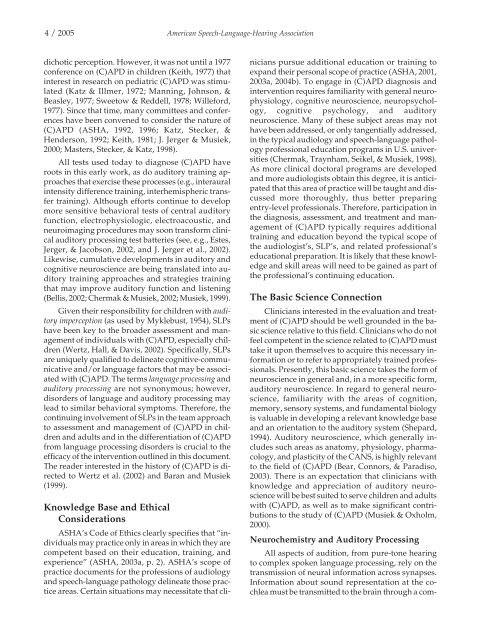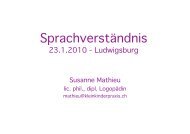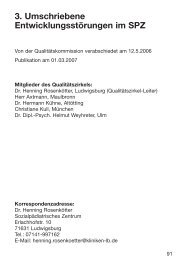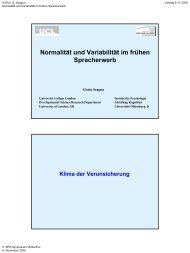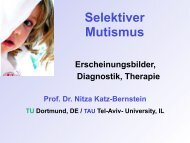(Central) Auditory Processing Disorders - Technical Report
(Central) Auditory Processing Disorders - Technical Report
(Central) Auditory Processing Disorders - Technical Report
- No tags were found...
Create successful ePaper yourself
Turn your PDF publications into a flip-book with our unique Google optimized e-Paper software.
4 / 2005<br />
American Speech-Language-Hearing Association<br />
dichotic perception. However, it was not until a 1977<br />
conference on (C)APD in children (Keith, 1977) that<br />
interest in research on pediatric (C)APD was stimulated<br />
(Katz & Illmer, 1972; Manning, Johnson, &<br />
Beasley, 1977; Sweetow & Reddell, 1978; Willeford,<br />
1977).␣ Since that time, many committees and conferences<br />
have been convened to consider the nature of<br />
(C)APD (ASHA, 1992, 1996; Katz, Stecker, &<br />
Henderson, 1992; Keith, 1981; J. Jerger & Musiek,<br />
2000; Masters, Stecker, & Katz, 1998).<br />
All tests used today to diagnose (C)APD have<br />
roots in this early work, as do auditory training approaches<br />
that exercise these processes (e.g., interaural<br />
intensity difference training, interhemispheric transfer<br />
training). Although efforts continue to develop<br />
more sensitive behavioral tests of central auditory<br />
function, electrophysiologic, electroacoustic, and<br />
neuroimaging procedures may soon transform clinical<br />
auditory processing test batteries (see, e.g., Estes,<br />
Jerger, & Jacobson, 2002, and J. Jerger et al., 2002).<br />
Likewise, cumulative developments in auditory and<br />
cognitive neuroscience are being translated into auditory<br />
training approaches and strategies training<br />
that may improve auditory function and listening<br />
(Bellis, 2002; Chermak & Musiek, 2002; Musiek, 1999).<br />
Given their responsibility for children with auditory<br />
imperception (as used by Myklebust, 1954), SLPs<br />
have been key to the broader assessment and management<br />
of individuals with (C)APD, especially children<br />
(Wertz, Hall, & Davis, 2002). Specifically, SLPs<br />
are uniquely qualified to delineate cognitive-communicative<br />
and/or language factors that may be associated<br />
with (C)APD. The terms language processing and<br />
auditory processing are not synonymous; however,<br />
disorders of language and auditory processing may<br />
lead to similar behavioral symptoms. Therefore, the<br />
continuing involvement of SLPs in the team approach<br />
to assessment and management of (C)APD in children<br />
and adults and in the differentiation of (C)APD<br />
from language processing disorders is crucial to the<br />
efficacy of the intervention outlined in this document.<br />
The reader interested in the history of (C)APD is directed<br />
to Wertz et al. (2002) and Baran and Musiek<br />
(1999).<br />
Knowledge Base and Ethical<br />
Considerations<br />
ASHA’s Code of Ethics clearly specifies that “individuals<br />
may practice only in areas in which they are<br />
competent based on their education, training, and<br />
experience” (ASHA, 2003a, p. 2). ASHA’s scope of<br />
practice documents for the professions of audiology<br />
and speech-language pathology delineate those practice<br />
areas. Certain situations may necessitate that clinicians<br />
pursue additional education or training to<br />
expand their personal scope of practice (ASHA, 2001,<br />
2003a, 2004b). To engage in (C)APD diagnosis and<br />
intervention requires familiarity with general neurophysiology,<br />
cognitive neuroscience, neuropsychology,<br />
cognitive psychology, and auditory<br />
neuroscience. Many of these subject areas may not<br />
have been addressed, or only tangentially addressed,<br />
in the typical audiology and speech-language pathology<br />
professional education programs in U.S. universities<br />
(Chermak, Traynham, Seikel, & Musiek, 1998).<br />
As more clinical doctoral programs are developed<br />
and more audiologists obtain this degree, it is anticipated<br />
that this area of practice will be taught and discussed<br />
more thoroughly, thus better preparing<br />
entry-level professionals. Therefore, participation in<br />
the diagnosis, assessment, and treatment and management<br />
of (C)APD typically requires additional<br />
training and education beyond the typical scope of<br />
the audiologist’s, SLP’s, and related professional’s<br />
educational preparation. It is likely that these knowledge<br />
and skill areas will need to be gained as part of<br />
the professional’s continuing education.<br />
The Basic Science Connection<br />
Clinicians interested in the evaluation and treatment<br />
of (C)APD should be well grounded in the basic<br />
science relative to this field. Clinicians who do not<br />
feel competent in the science related to (C)APD must<br />
take it upon themselves to acquire this necessary information<br />
or to refer to appropriately trained professionals.<br />
Presently, this basic science takes the form of<br />
neuroscience in general and, in a more specific form,<br />
auditory neuroscience. In regard to general neuroscience,<br />
familiarity with the areas of cognition,<br />
memory, sensory systems, and fundamental biology<br />
is valuable in developing a relevant knowledge base<br />
and an orientation to the auditory system (Shepard,<br />
1994). <strong>Auditory</strong> neuroscience, which generally includes<br />
such areas as anatomy, physiology, pharmacology,<br />
and plasticity of the CANS, is highly relevant<br />
to the field of (C)APD (Bear, Connors, & Paradiso,<br />
2003). There is an expectation that clinicians with<br />
knowledge and appreciation of auditory neuroscience<br />
will be best suited to serve children and adults<br />
with (C)APD, as well as to make significant contributions<br />
to the study of (C)APD (Musiek & Oxholm,<br />
2000).<br />
Neurochemistry and <strong>Auditory</strong> <strong>Processing</strong><br />
All aspects of audition, from pure-tone hearing<br />
to complex spoken language processing, rely on the<br />
transmission of neural information across synapses.<br />
Information about sound representation at the cochlea<br />
must be transmitted to the brain through a com-


